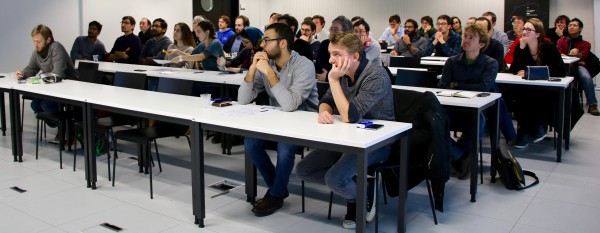MARVEL Junior Seminar — October 2020
Zoom meeting link:
https://epfl.zoom.us/j/93881551248
Password: 3417
The MARVEL Junior Seminars aim to intensify interactions between the MARVEL Junior scientists belonging to different research groups.
Each seminar consists of two presentations of 25 minutes each, allowing to present on a scientific question in depth, followed by time for discussion. The discussion is facilitated and timed by the chair.

MARVEL Junior Seminar Organizing Committee — Michele Kotiuga, Sara Fiore, Stefano Falletta, Kristians Cernevics, Max Veit and Patrick Mayor
Talk 1 — Doping solid-state electrolytes: a pinball model study
Loris Ercole1, Leonid Kahle2, Giuliana Materzanini1, Nicola Marzari1
1 Laboratory of Theory and Simulation of Materials (THEOS), EPFL
2 IBM Research Zurich
Lithium-ion solid-state electrolytes (SSEs) hold promise of becoming the key component of next-generation batteries, by addressing the increasing demands for improved safety and higher energy density. In the last 20 years, several compounds featuring high-ionic and low-electronic conductivities have been identified, but no known material satisfies all the requirements needed for a successful deployment. Chemical substitutions represent a powerful strategy to tune the properties of promising candidates. In particular, aliovalent doping can introduce vacancies on the Li sites and enhance the Li mobility, but at the same time it may perturb the potential-energy landscape, possibly hindering Li-ion diffusion [1].
We study these two interwoven effects by means of molecular dynamics and the Pinball model [2], a hybrid ab-initio/semi-empirical potential able to describe the diffusion of Li ions in a host lattice at the level of accuracy of DFT but a much reduced cost. We identify the optimal Li amount to maximize the ionic conductivity of Li7La3Zr2O12 [3]; we then study the effects of cation substitutions and of the lattice arrangement of dopants on Li transport.
[1] M. Mottet et al., Phys. Rev. Materials 3, 035403 (2019)
[2] L. Kahle et al., Phys. Rev. Materials 2, 065405 (2018)
[3] V. Thangadurai et al., J. Am. Ceram. Soc. 86, 437 (2003). R. Murugan et al., Angew. Chem. Int. Ed. 46, 7778 (2007).
Talk 2 — Bottom-up fabrication of graphene nanoribbons: from molecules to devices
Gabriela Borin Barin1, Juan Pablo Llinas2, Jan Overbeck3, Mickael Perrin3, Maria El Abassi3, Colin Daniels4, Akimitsu Narita5, Vincent Meunier4, Klaus Müllen5, Michel Calame3, Jeffrey Bokor2, Pascal Ruffieux1, Roman Fasel1
1 nanotech@surfaces Laboratory, Empa
2 Dept of Electrical Eng. and Comp Sciences, UC Berkeley
3 Transport at Nanoscale interface Lab, Empa
4 Applied Physics and Astronomy Dept, Rensselaer Polytechnic Institute
5 Max Planck Institute for Polymer Research Mainz
Atomically precise graphene nanoribbons (GNRs) have shown great potential to further stretch the upcoming scaling limit of integrated circuits technology. GNRs exhibit a sizeable bandgap, which is inversely proportional to their width, and are thus excellent candidates for room temperature switching applications such as field-effect transistors (FET). Despite their exceptional properties, significant challenges remain for GNR fabrication, processing and characterization. Bottom-up synthesis of graphene nanoribbons is most commonly performed under ultra-high vacuum conditions, which is one of the bottlenecks in the further technological advancement of this material. Additionally, little is known about the stability of ultra-narrow GNRs under ambient conditions or during device processing. In this talk I will address these critical challenges, focusing on GNR fabrication scalability, substrate transfer, ex-situ characterization, and show that gate and channel length optimization on GNR-FET allows for the fabrication of GNRs devices with high on currents and on/off ratios.
Check the list of the next MARVEL Junior Seminars here.
Low-volume newsletters, targeted to the scientific and industrial communities.
Subscribe to our newsletter